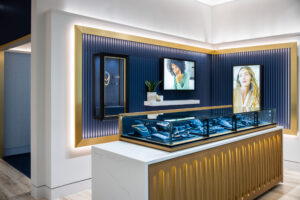How can brick-and-mortar retail stores compete with the convenience of online shopping? They can’t.
So, the question becomes, how can physical retail locations justify a trip to the store? The answer lies in creating experiences and valuable customer engagement that they can’t get online. The experiential retail design transforms traditional brick-and-mortar stores into immersive environments that engage customers on a deeper level. By focusing on creating memorable interactions, storytelling, and sensory experiences, retailers can forge meaningful connections that transcend mere transactions.
The Rise of Experiential Retail Design
In recent years, experiential retail design has gained momentum. Brands have recognized the importance of offering more than just a storefront, something they already have access to on the couch at home. With the rise of e-commerce, consumers need a better reason to show up in person. From pop-up installations to interactive displays, brands are finding creative ways to immerse customers in their brand story and create memorable moments that leave a lasting impression.

The Value of Experience
Experiential retail offers several key benefits for brands looking to stand out in a crowded market. One of the most significant advantages is its ability to generate earned media. When customers have a memorable experience in-store, they are more likely to share it with their friends and followers on social media, leading to increased brand awareness and exposure. Additionally, experiential retail can boost brand perception by creating positive associations with the brand and enhancing its image as innovative and customer-centric.
Brick-and-mortar retail stores can leverage their unique advantages over online storefronts to drive conversions in the moment. When customers are engaged and emotionally invested in the brand experience, they are more likely to make a purchase and become repeat customers.
How many memorable experiences have you had shopping online? Experiential retail helps brands differentiate themselves from competitors by offering unique and memorable experiences that can only happen in the real world. This differentiation can lead to increased customer loyalty and premium pricing, as customers are willing to pay more for brands that provide exceptional experiences.
Experience By Design
Interior design plays a pivotal role in enabling retail experiences by shaping the physical environment to evoke specific emotions, tell stories, and engage customers on a deeper level. Through thoughtful selection of layout, lighting, color schemes, materials, and furnishings, interior designers create immersive spaces that align with the brand’s identity and narrative.
For instance, strategic placement of products and interactive displays encourages exploration and interaction, while dynamic lighting enhances the ambiance and highlights key focal points. The use of textures, scents, and soundscapes stimulates the senses, evoking positive emotions and forging strong emotional connections with customers. Ultimately, interior design serves as the foundation upon which experiential retail experiences are built, creating memorable moments that leave a lasting impression on customers.
What physical design elements would promote experiences that align with your brand and captivate your audience?
Our work: NewGround helped design a new physical retail experience for Blue Nile

Strategies for Leveraging Experiential Retail
To leverage experiential retail effectively, brands must adopt a strategic approach that aligns with their goals and target audience. One strategy is to create engaging points of contact throughout the store, such as interactive displays, demo stations, and product try-ons. These points of contact allow customers to interact with the brand in a meaningful way and learn more about its products and services.
Another proven tactic is to host events and appointment product drops that bring the brand to life and create opportunities for customers to engage with the brand in a social setting. Whether it’s a product launch party, a workshop, or a live demonstration, events can drive foot traffic to the store and foster a sense of community among customers.
Additionally, brands can leverage social media trends to create buzz around their unique in-store initiatives. By tapping into popular trends and influencers, brands can reach a wider audience and generate excitement about their store experience.
Technology also plays a crucial role in experiential retail, with augmented reality (AR) and virtual reality (VR) being increasingly used to create immersive experiences. From virtual try-on experiences to interactive digital displays, technology allows brands to create unique and engaging experiences that captivate customers and drive engagement.
Partner for Success
It isn’t easy to compete with online shopping, but physical retail locations have some distinct advantages. As a fully integrated strategy, design, and build firm, NewGround specializes in helping brands create immersive retail experiences that resonate with customers and drive business success. From concept development to execution, our team works closely with clients to bring their vision to life and create unforgettable experiences that leave a lasting impression.
Experiential retail design offers brands a powerful tool for creating immersive and interactive environments that drive engagement, foster loyalty, and connect with customers on a deeper level. By leveraging innovative strategies, technology, and partnerships, brands can differentiate themselves in a competitive market and create meaningful experiences that keep customers coming back for more. As the retail landscape continues to evolve, unique and memorable experiences will play an increasingly important role in shaping the future of retail and driving business success.
Ready to elevate your retail experience and forge meaningful connections with your customers? Contact NewGround today to learn how we can help you create immersive and unforgettable retail spaces that drive engagement and foster brand loyalty.